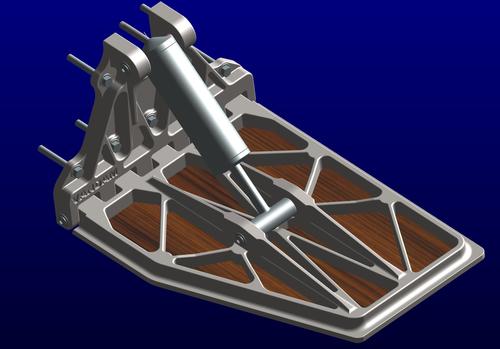October 3, 2014

When you're in the custom transportation business and designing cars, planes, or boats to meet one person's needs, taste, or budget, you never know what's going to come through the door next.
That's the challenge facing Van Dam Custom Boats of Boyne City, Mich., but it's one the company relishes. As design engineer Michel Berryer explains, "Each new client walks through the door with a dream, and it's up to us to make that dream happen."
With a naval architect, Principal Ben Van Dam, and Berryer on staff, the company has the ability to create a world-class custom wooden boat or yacht, regardless of its complexity. A team of 10 to 12 skilled boat builders work on two to four boats a year, depending on the size. Every boat is different, but each fulfills a vision. "We're not a cookie cutter company. We're not building 20 of one model. And the shapes we achieve with wood blow people's minds," Berryer said. "I think everybody recognizes that wood really only likes to bend in one direction, it doesn't like to bend in two -- but we seem to do that every day of the week. People scratch their heads and ask themselves, 'How did they do that?'"
The answer: It's a process called cold molding, in which a room-temperature cure epoxy adhesive is used to laminate thin layers of wood to create the large structural members of the hull and the hull itself. The company engineers all the structural members, joints, and skins this way to create a wooden boat that is strong, durable, and stable.
Click on the Van Dam custom boat below to start the slideshow.

State-of-the-art computer aided design programs are incorporated throughout the planning and building process, and metal fabrication and mechanical systems are assembled on site.
As Berryer and team embark on a new boat or yacht design, they must first decide which technique they will use to build the structural framework. This is because there are several approaches that can emphasize either the longitudinal or the transverse framing, or both. The team studies the various conditions the vessel will encounter, and the overall style of the boat, and then decides which framing system will work best. This structure is then integrated into the design using 3D CAD software.
This same software enables the team to generate full-size patterns that are accurate to a few thousandths of an inch so that they can map out the boat's framework, mechanical systems, and seating. They also use the data to CNC-machine custom fittings and hardware.
Each boat is engineered to take advantage of wood as a unidirectional fiber, because the material is much stronger along the grain than it is across the grain. The team hand selects each piece of lumber, looking for characteristics that might dictate whether it is used for structure, cosmetics, or, in some cases, both. Inside or out, the joinery and structures are never hidden from view, so the wood must always be expertly fit and finished.
While the Van Dam team is skilled in woodcraft, they also possess the skill and the equipment to fabricate custom fittings in stainless steel or aluminum on site. These combine artistry with functionality and can range from polished cutwaters to propeller shaft struts, and everything in between.
Berryer said he first came across igus plastic bushings and plain bearings during a stint working for General Motors. When President Steve Van Dam hired him almost 20 years ago, Berryer reinvested that knowledge, and today installs igus components on every vessel he sends out the door.
Primarily, he says he uses them wherever he needs smooth operation for a moving part of some description, such as several bar linkages, or wherever he requires some kind of isolation between two metal components. He designed a custom set of trim tabs for the boat he's currently working on and they are festooned with igus bushings to isolate the pivot shaft from the base metal, so there's no metal-on-metal rotating surface.
Some boats naturally have more applications than others, such as opening and closing doors, raising and lowering seats. The more complex the requested feature, the more bearings are installed. Berryer recently specified igus' DryLin linear slides for an application to allow a hatch to index back and forth on a gear motor using a rack and pinion.
Michael Hardy is marketing manager for igus.
Related posts:
About the Author(s)
You May Also Like





